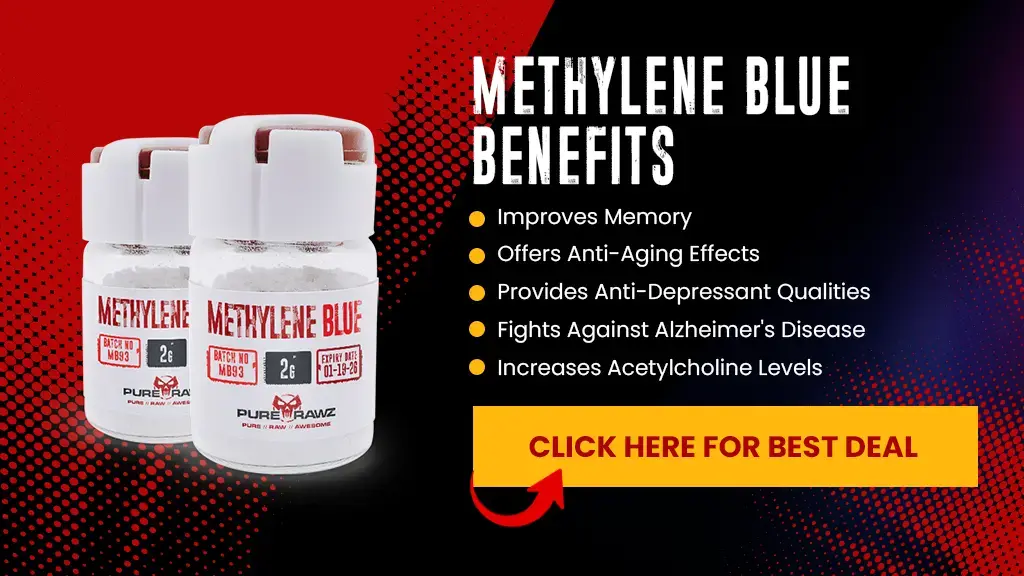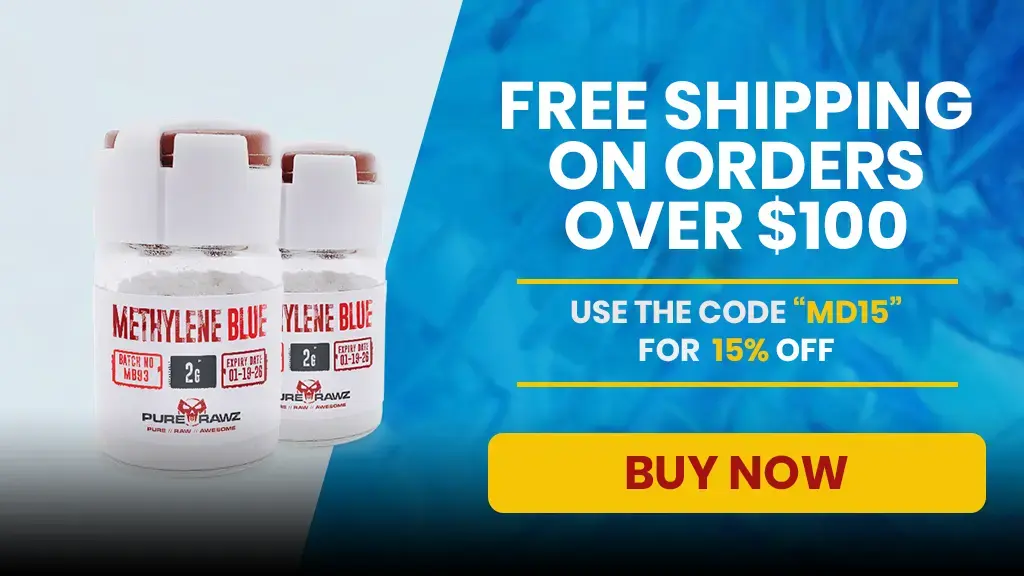Introduction

Unassuming yet immensely powerful, methylene blue is a fascinating chemical compound that has captured the interest of scientists and biohackers alike. This brilliant blue synthetic dye, first discovered in the late 19th century, has undergone a remarkable journey – evolving from a mere textile colorant to a multi-talented therapeutic agent with vast potential.
As research continues to unravel the mysteries of methylene blue, it becomes increasingly clear that this “magic bullet” molecule may hold the key to unlocking a wealth of cognitive and neurological benefits. From boosting memory and focus to combating neurodegenerative diseases, methylene blue’s mechanisms of action are as impressive as they are in complex volume.
Join us as we delve into the remarkable world of this unsung hero, exploring its rich history, cutting-edge applications, and the scientific insights that have propelled it to the forefront of natural nootropic and neuroprotective compounds.
Product Information
| Methylene Blue | |
| CAS Number | 61-73-4 |
| Molar Mass | 319.85 g·mol−1 |
| Chemical Formula | C16H18ClN3S |
| IUPAC Name | 3,7-bis(Dimethylamino)-phenothiazin-5-ium chloride |
You know, methylene blue is a really fascinating compound with a rich history and some very intriguing potential modern applications. Let me give you the full scoop on this “magic bullet” molecule.
It all started back in 1876 when a German chemist named Heinrich Caro first cooked up this blue dye derived from aniline over at the BASF labs. Originally it was just used for staining cotton fabrics that brilliant blue color. [R]
But then in 1891, another German scientist, the famous Paul Ehrlich, made a huge discovery – methylene blue could actually treat malaria when injected into the body! Ehrlich was so impressed by how it seemed to hunt down and target the malaria parasites, he coined the term “magic bullet” to describe it.
For decades after that, methylene blue, or methylthioninium chloride as it’s formally called, saw use treating all kinds of conditions – from dementia to urinary tract infections to cyanide poisoning. The way it can selectively concentrate in diseased tissues is just wild. But then better malaria drugs like chloroquine came along and methylene blue fell out of favor for that use. [R]
Well fast forward to today, and methylene blue is making a comeback! Cutting-edge research shows it could be a new weapon against malaria strains that have developed resistance to our current medications. It actually inhibits Plasmodium falciparum, which is one of the real nasty, life-threatening varieties. On top of that, methylene blue can treat a condition called methemoglobinemia where your blood can’t carry oxygen properly anymore – literally saving lives there. [R][R][R]
But perhaps most excitingly, methylene blue is conquering a new region. This compound can be a potential neuroprotective agent that could help fight devastating neurological diseases like Alzheimer’s.
Get this – as a nootropic, it gives your mitochondria a boost, increases blood flow to the brain, and even has antidepressant effects. Plus, it seems to reduce those rogue oxygen radicals that damage our neurons over time. Pretty amazing for an old cotton dye, right?
So in summary, this unassuming blue powder has a long and fascinating history as a true “magic bullet” therapy. But the best part is, thanks to modern research, methylene blue may just be getting started in treating some of our most difficult diseases. Who knows what other tricks this “blue magic” compound has up its sleeve!
Is Methylene Blue Legal?
Methylene blue is generally legal and available as a laboratory chemical or a medication in many countries. It is commonly used as a dye in laboratories and has various medical applications, including as a treatment for certain conditions.
However, its use as a nootropic, which refers to substances believed to enhance cognitive function, is not as well-established or regulated. Some people have experimented with methylene blue for potential cognitive benefits, but it’s important to note that the safety and efficacy of such uses are not fully understood. Additionally, regulations regarding the sale and use of nootropics can vary by jurisdiction.
How Does Methylene Blue Work?
methylene blue is a real multi-tasker when it comes to boosting your brain power. It’s got a couple of main superpowers we need to cover.
Source: ResearchGate
Methylene Blue Improves Memory
First up, it’s a memory enhancement wizard. But instead of just fiddling with neurotransmitters like some nootropics, MB gets down to the cellular level. It straight-up improves how your brain cells utilize that precious oxygen we all need. Studies have shown big jumps in oxygen consumption and glucose uptake when you’re rocking the methylene blue.
See, MB acts as an alternative electron carrier in the mitochondria’s electron transport chain. It essentially accepts spare electrons from NADH and shuttles them on to cytochrome c to keep that energy production fired up. By increasing that cellular metabolic rate and glucose metabolism, more ATP gets pumped out to fuel cognitive functions like memory, mood, and overall brain performance. More fuel for the mental fire!
Methylene Blue Functions as an Antioxidant
But MB’s second superpower is maybe even more clutch – it’s an antioxidant assassin. This blue brew has a completely unique way of taking out free radicals and oxidative stress compared to other antioxidants. It goes straight for the source – binding to the first free radical formed, superoxide, and reducing it down to water before it can kick off a cascade of cell damage.
So get this – methylene blue both amps up cellular energy production, which normally cranks out oxidative stress…AND simultaneously eliminates that oxidative stress! A real twisted pair of talents.
Researchers have seen MB work its magic in nasty neurological cases too. Like when it rescued mitochondria from a brain-area dopamine depletion similar to Parkinson’s just by rerouting the broken electron transport chain. Or how it protects against stroke and brain injury reperfusion damage by donating those spare electrons.
In Parkinson’s models, MB dramatically reversed behavioral, neurochemical, and brain pathology impairments – both by that electron transport shunting and antioxidant one-two punch.
The bottom line is methylene blue’s mechanisms are wildly impressive across the board for cognitive enhancement and neuroprotection. It’s like a Swiss Army knife of brain-biohacking!
Methylene Blue Benefits

- Methylene Blue Improves Memory
Studies in animals have shown that even a single low dose of methylene blue can significantly improve long-term contextual memory. Contextual memory refers to the conscious recollection of the specific source and circumstances surrounding a particular memory. [R]
Interestingly, research has found that taking methylene blue after a learning event or experience can also boost memory retention of that event. One study conducted on rats helps explain how this works:
In this experiment, rats received a 1 mg/kg dose of methylene blue for 3 consecutive days after their training sessions. The researchers then measured the activity levels of cytochrome c oxidase, an enzyme involved in cellular energy production, in the rats’ brains.
The findings revealed that in the group treated with methylene blue, cytochrome c oxidase activity in the brain was a remarkable 70% higher compared to the placebo group.
This suggests that the repeated post-training supplementation of methylene blue enhanced memory consolidation – the process of converting newly learned information into lasting long-term memories. This memory boost is thought to occur due to methylene blue’s ability to increase metabolic capacity and energy production in the specific brain regions that are highly active during learning and memory formation.
In simple terms, by providing these memory-critical brain areas with more cellular energy in the form of ATP, methylene blue optimizes the neurological processes involved in solidifying and retaining new information and experiences as long-lasting memories.
So in essence, methylene blue acts as a memory aid by supplying extra metabolic fuel to power the high-energy demands of learning, encoding, and storing new memories more efficiently and robustly in the brain.
This makes methylene blue a potentially valuable tool for enhancing cognitive abilities like memory retention, especially when taken after demanding learning sessions, important events, or any experiences you want a vivid recollection of in the future.
You might be interested in our other articles.
- Methylene Blue Offers Anti-Aging Effects
Research shows that methylene blue can act as an effective anti-aging nootropic compound by providing several key benefits at the cellular level.
First, it increases the activity of mitochondrial complex IV, which is the last enzyme in the respiratory electron transport chain within mitochondria, by around 30%. This final step is crucial for synthesizing ATP, the cellular energy currency that powers virtually all biological processes. [R]
Methylene blue has also been found to significantly enhance overall cellular oxygen consumption by 37-70%. Increased oxygen utilization allows for more efficient ATP production from the mitochondria.
Additionally, methylene blue promotes heme synthesis. Heme is an essential component containing iron that participates in oxygen transport, DNA synthesis, and electron transport reactions. Since heme synthesis begins in the mitochondria, boosting this process supports proper mitochondrial and overall cellular function. [R]
Perhaps most importantly, methylene blue can help reverse premature cellular senescence caused by oxidative stressors like hydrogen peroxide (H2O2) or the toxic metal cadmium. Senescence refers to the gradual deterioration of cell function and eventual cell death that underlies the aging process.
Methylene blue acts as a “redox agent” that can cycle between oxidized and reduced forms. This cycling helps disrupt the production of oxidants within mitochondria that would otherwise contribute to senescence and aging by damaging DNA, proteins and lipids over time.
By protecting against premature senescence triggered by reactive oxygen species and toxins, methylene blue can help extend the functional lifespan of cells throughout the body, including high-energy demanding neurons in the brain. [R]
In summary, methylene blue combats key aspects of aging at the cellular level by optimizing mitochondrial function, oxygen utilization, heme availability and preventing oxidative damage that leads to accelerated cellular senescence and decline. Its multi-pronged effects make it a promising anti-aging nootropic compound.
- Methylene Blue Provides Anti-Depressant Qualities
Methylene blue acts as a monoamine oxidase inhibitor (MAOI), which means it blocks the enzymes monoamine oxidase A (MAO-A) and monoamine oxidase B (MAO-B) that break down key neurotransmitters like serotonin, dopamine, and norepinephrine in the brain. At higher doses, methylene blue inhibits both MAO-A and MAO-B effectively. [R]
By inhibiting MAO and preventing the breakdown of these neurotransmitters, methylene blue can increase their available levels and neurotransmission in the brain. This mechanism is similar to how some prescription antidepressant drugs work.
Research has backed up methylene blue’s antidepressant effects. In a 1987 study, a low dose of just 15mg per day of methylene blue was found to be a potent antidepressant in patients with severe depression.
Another study looked at methylene blue’s effects in 31 patients with bipolar disorder who were already taking lithium. Patients received either 300mg or 15mg doses of methylene blue daily in addition to lithium. [R] [R]
The results showed that the 300mg methylene blue dose was “a useful addition to lithium in the long-term treatment of manic-depressive (bipolar) psychosis.” Patients taking this higher methylene blue dose experienced significantly reduced depression symptoms compared to the lower 15mg dose group.
This MAOI antidepressant mechanism, along with methylene blue’s other neuroprotective and cognitive-enhancing properties, makes it a promising natural compound for potentially improving mood, curbing depressive symptoms, and supporting overall mental health and wellbeing.
- Methylene Blue Fights Against Alzheimer’s Disease
Alzheimer’s disease and other forms of dementia are characterized by the buildup of abnormal proteins in the brain, particularly tau protein. Encouragingly, clinical trials have shown that methylene blue can inhibit the formation and accumulation of tau proteins. For this reason, methylene blue is being actively investigated as a potential treatment for Alzheimer’s disease. [R]
Beyond just inhibiting tau, methylene blue appears to provide multi-pronged neuroprotective effects that counteract several key pathways involved in the progression of Alzheimer’s disease. For example, it boosts the resistance of neurons (brain cells) to the formation of amyloid plaques and neurofibrillary tangles – two other hallmark proteins that damage neurons in Alzheimer’s.
Methylene blue has also been found to help repair impairments in mitochondrial function and cellular metabolism in neurons. This is significant because Alzheimer’s is associated with mitochondrial dysfunction and energy depletion in brain cells. [R]
Additionally, research shows that the cholinergic, serotonergic, and glutamatergic neurotransmitter systems all play critical roles in the development of Alzheimer’s disease and cognitive decline. Promisingly, methylene blue appears to provide beneficial effects by modulating and improving signaling through these important neurochemical pathways.
Most existing Alzheimer’s treatments can only prevent further progression before the disease is clinically diagnosed. However, methylene blue shows promise as a therapy that could potentially delay the effects and symptoms of Alzheimer’s disease and dementia even after diagnosis and onset.
- Methylene Blue Increases Acetylcholine Levels
Acetylcholine is a crucial neurotransmitter in the brain that plays an essential role in learning, memory, and cognitive function. Levels of acetylcholine tend to decline with age, which contributes to cognitive impairment and neurodegenerative diseases like Alzheimer’s.
Research shows that methylene blue acts as an acetylcholinesterase inhibitor. Acetylcholinesterase is the enzyme responsible for breaking down and deactivating acetylcholine in the brain. By inhibiting this enzyme, methylene blue prevents the premature breakdown of acetylcholine. [R]
This allows acetylcholine to remain available for longer periods and continue transmitting signals between neurons involved in cognition, learning, and memory formation. In other words, methylene blue increases functional levels of this vital neurotransmitter in the brain.
Other Nootropics as Alternative for Phenibut HCl
Phenibut HCL Powder
Phenibut HCl, short for Phenibut Hydrochloride, is a medication designed in Russia as a potential alternative to addictive substances like alcohol. It works by mimicking GABA, a brain chemical that promotes relaxation and sleep. While marketed online and in stores as a supplement for anxiety, sleep, and even curbing withdrawal symptoms from other drugs, Phenibut HCl isn’t approved by the FDA. A significant drawback is the risk of dependence. Stopping Phenibut HCl abruptly can trigger withdrawal symptoms similar to the very anxieties it aims to reduce. If considering Phenibut HCl, it’s crucial to weigh the risks and benefits, start with minimal doses, and avoid daily use to minimize the chance of addiction.
Noopept
Noopept, a synthetic nootropic, is under investigation for its potential benefits in cognitive health. Clinical studies suggest it might be helpful for people with mild cognitive disorders by reducing anxiety, irritability, and sleep problems, potentially leading to improved emotional well-being. Interestingly, human research also points towards Noopept’s ability to shorten recovery time after brain injuries. While preclinical studies in animals show promise for enhancing memory formation and retrieval, more research is needed to confirm these findings in humans. It’s important to remember that Noopept is still a research chemical, and its long-term safety and efficacy are not yet fully understood.
Piracetam
Piracetam is a medication with properties that could benefit the brain in multiple ways. Studies suggest it might act as a neuroprotectant, shielding brain cells from damage, and even have anti-seizure effects. Piracetam shows promise in improving verbal learning and memory, especially for those with dyslexia or dementia. Furthermore, it might enhance cognitive function, memory, and focus in people with circulation problems affecting the brain. There’s even some research indicating it could help reduce breath-holding spells in children. However, it’s important to note that more research is needed to confirm these potential benefits.
Pramiracetam
Pramiracetam is a nootropic drug currently in the experimental stage. Belonging to the “racetam” family alongside Piracetam, it holds promise for cognitive enhancement. While the exact way it affects the brain and specific cognitive functions remains under investigation, Pramiracetam has been studied for its potential use in treating Alzheimer’s disease and aiding memory and cognitive issues following electroconvulsive therapy for severe depression. However, it’s important to remember that Pramiracetam is not yet a licensed medication and is still considered a research chemical. This means its safety and effectiveness for long-term use haven’t been fully established.
Oxiracetam
Oxiracetam, a racetam nootropic like Piracetam, stands out for its potential to improve memory and cognitive function. Studies suggest it can cross the blood-brain barrier, possibly aiding in conditions like neurodegenerative diseases, memory deficits, strokes, seizures, and even anxiety. Interestingly, compared to Piracetam, Oxiracetam appears to be more effective in tackling cognitive impairment and boosting memory. Clinical trials also show it has good absorption by the body (bioavailability) and lasts for a moderate amount of time (3-6 hour half-life).
Methylene Blue Side Effects

Methylene blue exhibits what’s known as a “hormetic dose-response” – meaning it can have opposite effects at low versus high doses. Lower doses tend to be beneficial and provide the desired nootropic cognitive-enhancing effects. However, higher doses can potentially cause problems.
At higher doses, methylene blue may interfere with the normal electron transport chain in mitochondria by “stealing” electrons away from it. This disrupts the critical redox balance and can cause methylene blue to act as a pro-oxidant instead of an antioxidant, generating harmful free radicals rather than reducing them.
Another safety issue with methylene blue, even pharmaceutical-grade versions, is the risk of contaminants and impurities. It can contain heavy metals like arsenic, aluminum, cadmium, mercury, and lead which increase the risk of heavy metal toxicity, especially at higher dosages that allow more accumulation in cells over time.
For patients with impaired liver function, high doses of serotonergic compounds like methylene blue may need to be avoided or closely monitored by a doctor due to risks of toxicity buildup that the liver can’t properly clear.
When methylene blue is used at relatively low doses below around 2mg/kg body weight, side effects are quite rare. But some potential side effects that have been reported include stomach/chest pain, dizziness, headaches, sweating, confusion, high blood pressure, shortness of breath, fast heartbeat, tremors, blue discoloration of skin/urine/feces, reduction in red blood cells, and jaundice (mostly seen in infants).
How Does Methylene Blue Make You Feel?
One of the most commonly reported effects is a sensation of full, comprehensive understanding after learning or studying new material. It’s as if methylene blue allows your brain to deeply encode and integrate that knowledge in a way that makes it stick permanently. You’ll likely feel confident that you can easily recall and apply what you learned going forward.
This ties into reports of enhanced “after-the-fact” learning with methylene blue. As you take in information, it seems to help your brain efficiently sort through, process, and optimize the storage of that material for future access. Many describe it like their mind is specially rewired for optimized memory consolidation.
Remarkably, some users say methylene blue has an almost emotional intelligence-boosting quality, allowing you to rewrite negative associations with past experiences and only retain the positive aspects of those memories. This could provide profound anxiety and stress relief benefits.
Speaking of anxiety, a very common theme is that methylene blue simply makes you “feel young again” – eliminating social anxiety, boosting confidence, clarity and focus. There are also frequently reported mood-brightening and motivational effects.
Physically, some users find methylene blue provides an energy boost, making workouts seem easier as it revs up those cellular mitochondria power plants. Recovery may also be faster. Overall, there’s a calm, relaxed, yet energized feeling frequently noted.
Finally, enhanced quality of sleep is another widely experienced benefit of methylene blue, likely tied to its stress-relieving and anxiolytic properties.
Recommended Dosage for Methylene Blue
Here are some recommended dosage guidelines and other important information about using methylene blue:
There is no definitive “recommended” dosage for methylene blue that has been established, as it can vary based on the intended use and an individual’s body weight. However, clinical studies involving both animals and humans report a general safe dosage range of 0.5 – 4 mg per kg of body weight.
For a 200 lb (90 kg) person, this translates to a dosage range of 45 mg on the low end up to 360 mg on the higher end. Personally, I would consider 360 mg to be an extremely high dose, even for larger individuals – that dosage level raises safety concerns.
Our recommendation would be to start with the lowest effective dose around 0.5 mg/kg of body weight. So for that 200 lb person, a reasonable starting dose is 45 mg. You can then take another low dose a few hours later if you don’t experience any effects from the initial amount.
Since methylene blue is water-soluble, it can be taken with or without food. It has a relatively short half-life of about 5 hours, so splitting the daily dose into two divided doses taken around 5 hours apart is reasonable.
One amusing but harmless side effect is that methylene blue will cause your urine to turn a blue or blue-green color – this is normal and temporary. It tends to only occur at doses over 500 mcg though. Some recommend mixing methylene blue with vitamin C/ascorbic acid a few hours before dosing to help prevent this staining effect.
For therapeutic medical uses like treating malaria or use alongside cancer therapies, methylene blue may be administered as an intravenous injection under medical supervision.
Frequently Asked Questions
What is methylene blue dye originally used for?
Methylene blue is a synthetic dye originally used for dyeing textiles and coloring cotton in the textile industry.
What conditions can methylene blue potentially treat?
Methylene blue has been used to treat metabolic disorders, urinary tract infections, cyanide poisoning, and other certain conditions. It shows potential for Alzheimer’s disease, dementia, and certain psychological disorders.
Is methylene blue safe for human health?
At typical lower dosages, methylene blue appears to be relatively safe and well-tolerated. However, higher doses may increase the risks of side effects and contamination issues. As always, consult a doctor before using.
What other disorder can methylene blue help address?
A patient was diagnosed with ifosfamide-induced encephalopathy (IRE), which is a condition that affects the brain and is related to the chemotherapy drug ifosfamide. To treat this condition, the patient was given intravenous (IV) methylene blue, which means the methylene blue was administered directly into the veins. The dosage of methylene blue used was 50 milligrams (mg) every 4 hours. [R]
After receiving four doses of the methylene blue treatment, the patient’s symptoms showed significant improvement. Within 72 hours (3 days), the symptoms completely resolved, meaning they went away entirely. With the successful treatment of the ifosfamide-related encephalopathy, the patient was able to complete the planned course of chemotherapy.
Where Can You Buy Methylene Blue Powder Online?
PureRawz is the best online store to buy Methylene Blue Powder.
To be the best supplier of research chemicals, we provide reference materials with every product we sell. Our products are all accompanied by an independent, third-party Certificate of Analysis for identification, purity, and concentration.

Conclusion
The story of methylene blue is one of scientific serendipity and boundless potential. What began as a humble dye has blossomed into a multi-faceted therapeutic marvel, captivating researchers and biohackers alike with its ability to enhance cognitive function, combat neurodegeneration, and potentially rewrite the narrative of aging itself.
From its roots as a “magic bullet” against malaria to its current status as a promising treatment for Alzheimer’s and other neurodegenerative conditions, methylene blue’s journey has been nothing short of extraordinary. And yet, the true depths of its capabilities remain largely unexplored, waiting to be uncovered by the relentless pursuit of scientific inquiry.
As we stand on the precipice of a new era in brain health and longevity, methylene blue emerges as a beacon of hope – a natural, multi-targeted compound that could hold the key to optimizing our most precious resource: the human mind.
